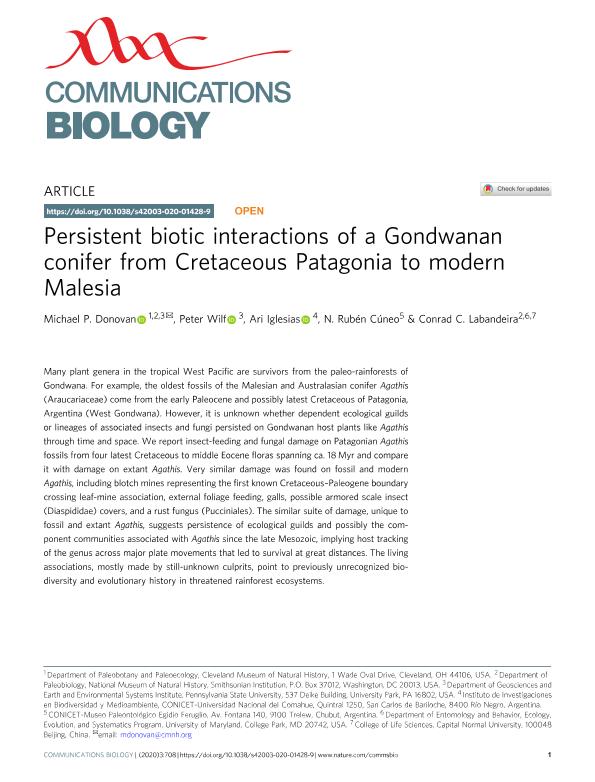Artículo
Persistent biotic interactions of a Gondwanan conifer from Cretaceous Patagonia to modern Malesia
Fecha de publicación:
11/2020
Editorial:
Nature
Revista:
Communications Biology
e-ISSN:
2399-3642
Idioma:
Inglés
Tipo de recurso:
Artículo publicado
Clasificación temática:
Resumen
Many plant genera in the tropical West Pacific are survivors from the paleo-rainforests of Gondwana. For example, the oldest fossils of the Malesian and Australasian conifer Agathis (Araucariaceae) come from the early Paleocene and possibly latest Cretaceous of Patagonia, Argentina (West Gondwana). However, it is unknown whether dependent ecological guilds or lineages of associated insects and fungi persisted on Gondwanan host plants like Agathis through time and space. We report insect-feeding and fungal damage on Patagonian Agathis fossils from four latest Cretaceous to middle Eocene floras spanning ca. 18 Myr and compare it with damage on extant Agathis. Very similar damage was found on fossil and modern Agathis, including blotch mines representing the first known Cretaceous–Paleogene boundary crossing leaf-mine association, external foliage feeding, galls, possible armored scale insect (Diaspididae) covers, and a rust fungus (Pucciniales). The similar suite of damage, unique to fossil and extant Agathis, suggests persistence of ecological guilds and possibly the component communities associated with Agathis since the late Mesozoic, implying host tracking of the genus across major plate movements that led to survival at great distances. The living associations, mostly made by still-unknown culprits, point to previously unrecognized biodiversity and evolutionary history in threatened rainforest ecosystems.
Palabras clave:
Cretaceous-Paleogene
,
interaction
,
Conifer
,
insect
Archivos asociados
Licencia
Identificadores
Colecciones
Articulos(INIBIOMA)
Articulos de INST. DE INVEST.EN BIODIVERSIDAD Y MEDIOAMBIENTE
Articulos de INST. DE INVEST.EN BIODIVERSIDAD Y MEDIOAMBIENTE
Citación
Donovan, Michael P.; Wilf, Peter; Iglesias, Ari; Cúneo, N. Rubén; Labandeira, Conrad C.; Persistent biotic interactions of a Gondwanan conifer from Cretaceous Patagonia to modern Malesia; Nature; Communications Biology; 3; 1; 11-2020; 1-9
Compartir
Altmétricas




